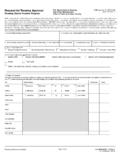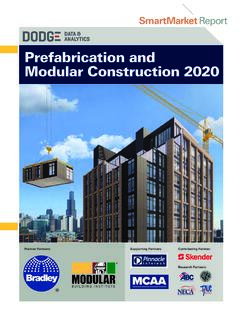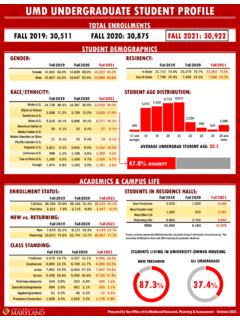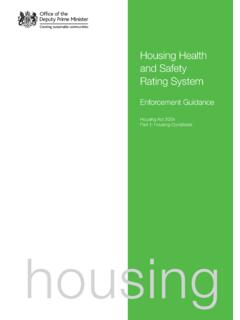Transcription of Ames, Iowa: Alternative to the Boston Housing Data as an ...
1 Journal of Statistics Education, Volume 19, Number 3(2011). Ames, Iowa: Alternative to the Boston Housing data as an End of Semester Regression Project Dean De Cock Truman State University Journal of Statistics Education Volume 19, Number 3(2011), Copyright 2011 by Dean De Cock all rights reserved. This text may be freely shared among individuals, but it may not be republished in any medium without express written consent from the author and advance notification of the editor. Key Words: Multiple Regression; Linear Models; Assessed Value; Group Project. Abstract This paper presents a data set describing the sale of individual residential property in Ames, Iowa from 2006 to 2010. The data set contains 2930 observations and a large number of explanatory variables (23 nominal, 23 ordinal, 14 discrete, and 20 continuous) involved in assessing home values.
2 I will discuss my previous use of the Boston Housing data Set and I will suggest methods for incorporating this new data set as a final project in an undergraduate regression course. 1. Introduction My first exposure to the Boston Housing data Set (Harrison and Rubinfeld 1978) came as a first year master's student at Iowa State University. Its analysis was the final assignment at the conclusion of the regression segment within our statistical methods class. The assignment was fairly open ended with a brief description of the data set and the simple task of finding a good model for the prediction of Housing prices. At the time, the data set seemed similar to others I. had encountered and it slipped from my memory until seven years later when I found myself as a new faculty member teaching my first regression course.
3 Although I had only recently begun my career in academia, I had already established the desire to incorporate some of the principles that would officially be recommended in the GAISE guidelines, such as the use of active learning, real data , and group work. In each of my other statistics classes, I had incorporated a final group project that integrated the concepts learned throughout the semester and I wanted to do the same in my regression course. 1. Journal of Statistics Education, Volume 19, Number 3(2011). For a regression project, I was looking for a data set that would allow students the opportunity to display the skills they had learned within the class. The ideal data set needed to have a reasonably large number of variables and observations so that students would have to go beyond a simple algorithm, such as forward or stepwise selection, to construct a final model.
4 At the time, I remembered the assignment from my own past and I searched the web to see if I could find the Boston Housing data Set ( ). I was surprised at the number of references and uses of the data set within the academic community and determined that its 506. observations and 14 variables would serve my purposes well. Over the years I have continued to use this data set, but with each passing year I have become more dissatisfied with its use. The original data set is from the 70's and the Housing prices have become unrealistic for today's market. I had contemplated inflating the prices by some set amount or scaling factor to obtain more contemporary values but that would change the data from real to realistic, which was not my preference.
5 As part of my sabbatical leave, one of my goals was to find a new data set that I could use as my final project. Although open to new subject areas, my hope was to find a more recent Housing data set as students are typically familiar with the variables associated with home evaluation. I. began my search by scouring sites such as DASL and the JSE data Archive and although I found several potential data sets ( Woodard and Leone 2008), the data sets were rather limited in the number of observations (n 100). A chance visit to my alma mater opened the door for the data set presented in this article. In chatting with some members of the Iowa State StatCom group about their current projects, a student mentioned the group was updating the assessment model used by the Ames City Assessor's Office.
6 They described the large number of variables and observations within the data set and I immediately set up an appointment with the City Assessor's Office to discuss the use of the data . After a brief meeting with the Assessor and Deputy Assessor outlining the data and the assessment process, I was given access to the data . The data came to me directly from the Assessor's Office in the form of a data dump from their records system. The initial Excel file contained 113 variables describing 3970 property sales that had occurred in Ames, Iowa between 2006 and 2010. The variables were a mix of nominal, ordinal, continuous, and discrete variables used in calculation of assessed values and included physical property measurements in addition to computation variables used in the city's assessment process.
7 For my purposes, a layman's data set that could be easily understood by users at all levels was desirable; so I began my project by removing any variables that required special knowledge or previous calculations for their use. Most of these deleted variables were related to weighting and adjustment factors used in the city's current modeling system. 2. The Ames Housing data After removal of these extraneous variables, 80 variables remained that were directly related to property sales. Although too vast to describe here individually (see the documentation file ), I will say that the 80 variables focus on the quality and quantity of many physical attributes of the property. Most of the variables are exactly the type of information that a typical home buyer would want to know about a potential property ( When was it built?)
8 How big is the lot? How many square 2. Journal of Statistics Education, Volume 19, Number 3(2011). feet of living space is in the dwelling? Is the basement finished? How many bathrooms are there?). In general the 20 continuous variables relate to various area dimensions for each observation. In addition to the typical lot size and total dwelling square footage found on most common home listings, other more specific variables are quantified in the data set. Area measurements on the basement, main living area, and even porches are broken down into individual categories based on quality and type. The large number of continuous variables in this data set should give students many opportunities to differentiate themselves as they consider various methods of using and combining the variables.
9 The 14 discrete variables typically quantify the number of items occurring within the house. Most are specifically focused on the number of kitchens, bedrooms, and bathrooms (full and half) located in the basement and above grade (ground) living areas of the home. Additionally, the garage capacity and construction/remodeling dates are also recorded. There are a large number of categorical variables (23 nominal, 23 ordinal) associated with this data set. They range from 2 to 28 classes with the smallest being STREET (gravel or paved) and the largest being NEIGHBORHOOD (areas within the Ames city limits). The nominal variables typically identify various types of dwellings, garages, materials, and environmental conditions while the ordinal variables typically rate various items within the property.
10 The coding within the original data typically utilized an eight-character name that was relevant to the classification but some of the original class levels were difficult to interpret. For ease of use many class levels were recoded into slightly more usable forms (see the documentation file ). Helpful Hint: Depending on the level of student, instructors may want to decide how much advice/direction they would like to give the students. They may want to code categorical variables into dummy variables ahead of time or may want to give students hints about how to combine or use the available variables. For my purposes I give the students the data as is and expect them to determine how the data could best be utilized.




